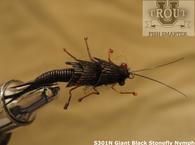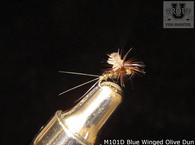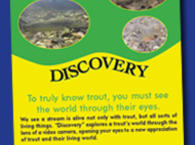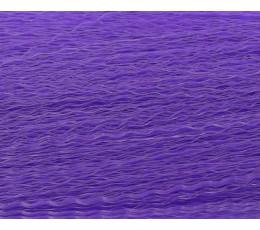Upon completion of this class the student will become aware of some of the most dangerous aquatic nuisances and where they are currently a growing problem. The student will know how to protect our trout waters from the hundreds of different harmful species ranging from plants, fish, amphibians, crustaceans, mollusks, diseases or pathogens. Note that some organisms are so small, you may not even realize they are traveling with you.
These aquatic nuisances can be transmitted from one waterway to the next in the damp felt soles of anglers’ shoes, as well as the linings of the shoes, breathable waders, fly lines and flies. Of course, nature will transmit some things by birds and animals.
Two of the most feared nuisances are the whirling disease and the Didymosphenia geminata, commonly referred to as didymo". Whirling disease is a parasite that attaches itself to trout and salmon.
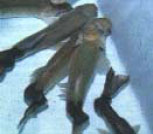 Juvenile trout affected with whirling disease.
Juvenile trout affected with whirling disease.
After coming into contact with the host fish, the parasite penetrates the head and spinal cartilage of fingerling trout where it multiplies very rapidly, putting pressure on the organ of equilibrium. This causes the fish to swim erratically (whirl) and have difficulty feeding and avoiding predators. It is this whirling effect that has provided the name for disease that has significantly impacted our coldwater fishery resources. While it affects all species of trout, rainbow trout and cutthroat trout appear to be more susceptible than other trout species. Whirling disease is having devastating impacts on coldwater fisheries in North America with large breakouts occuring throughout the Western States and the Northeastern States. Fortunately, it has not been found in the Southeastern States yet as far as we know.
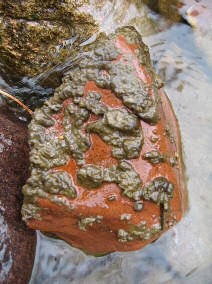 Didymosphenia geminata, commonly referred to as "didymo", is a freshwater microscopic diatom. It is found in streams and rivers in much of North America. Didymo increasingly poses a threat to aquatic ecosystems because it forms extensive mats on stream beds. Didymo attaches to the streambed by a stalk. These stalks have a rough texture similar to wet wool and mimic strands of toilet paper, as opposed to other algal species which feel "slimy". Often called the "Rock Snot" algae.
Didymosphenia geminata, commonly referred to as "didymo", is a freshwater microscopic diatom. It is found in streams and rivers in much of North America. Didymo increasingly poses a threat to aquatic ecosystems because it forms extensive mats on stream beds. Didymo attaches to the streambed by a stalk. These stalks have a rough texture similar to wet wool and mimic strands of toilet paper, as opposed to other algal species which feel "slimy". Often called the "Rock Snot" algae.
In the New York have called the algae “ferocious” and raised the possibility of trout “annihilation.” It can now be found in the Esopus River, the East and the West Branch of the Delaware River, the Battenkill River in New York But it can also be found in the Clinch River and the South Holston Rivers in North Carolina as well as Virginia and several western states as well.
Now, What the Student Can Do!
1.) Follow a general set of procedures every time you come in contact with any body of water. By doing so, you can protect your waters from harmful aquatic hitchhikers. Because you never know where a nuisance species has been introduced, but has yet to be discovered. Before leaving any body of water, it is important to examine all your equipment, boats, trailers, clothing, boots, buckets etc and:
- Remove any visible plants, fish or animals.
- Remove mud and dirt since it too may contain a hitchhiker.*
- Remove even plant fragments as they may contain a hitchhiker.*
- *The larvae (immature form) of an animal can be so tiny that you cannot see it. However, it can live in mud, dirt, sand, and on plant fragments.
2.) Eliminate water from all equipment before transporting anywhere.
Much of the recreational equipment used in water contains many spots where water can collect and potentially harbor these aquatic hitchhikers.
3.) Clean and dry anything that came in contact with the water.
(boats, trailers, equipment, dogs, boots, clothing, etc.). Basic procedures include:
- Use hot (< 40° C or 104° F) or salt water to clean your equipment.
-
The following recipes are recommended for cleaning hard-to-treat equipment that cannot be exposed to hot water:
- Dipping equipment into 100% vinegar for 20 minutes will kill harmful aquatic hitchhiker species.
- A 1 % table salt solution for 24 hours can replace the vinegar dip.
- If hot water is not available, spray equipment such as boats, motors, trailers, anchors, decoys, floats, nets, with high-pressure water. DRY Equipment, if possible, allow for 5 days of drying time before entering new waters.
4.) Do not release or put plants, fish or animals into a body of water unless they came out of that body of water. Whether you have obtained bait at a store or from another body of water, do not release unused bait into the waters you are fishing.
These measures may appear to be extreme. However, armed with this knowledge, these practices can become habit and they will help preserve our fisheries for future generations of trout fishers.
The reader is referred to these sites to become more aware of the threats to our trout fisheries:
Extra credit will be given to students who practice these methods of preventing the spread of Aquatic Nuisances.
Fro additional information please refer to the Invasive Species Action Network ISAN.


